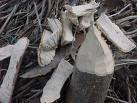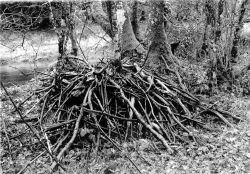This letter was written in response to a leaflet sent out by SWT & RZSS, hence the quotes.
'Beavers were once widespread in Scotland'. There is no evidence that they were in Knapdale. Without this evidence, the project is an introduction of an alien species. 'As a keystone species they would bring many benefits to a range of other native species and habitats'. Habitats in Knapdale already provide all of the possible benefits we are told will result from the introduction of beavers. There is already a rich diversity of habitat and wildlife which is threatened by mink, rhododendron and Japanese Knotweed – all non-native species which are invasive and costly to control. If, as we are told, the beaver has not been here for 400 years it can no longer be considered native.
'. . and have already been successfully re-established in 24 other European countries' The beaver is clearly not an endangered species and anecdotal evidence from Norway would indicate that the beaver has become a pest when living in close proximity to humans. This would be the case in Knapdale, which cannot be described as a wilderness area.
'64%of the public is in favour of the beaver returning' Who are these public? Do they live in areas which could potentially be affected by the beavers? The earlier consultation which informed the response from the public contained misinformation on the habits and effects of beavers and cannot be accepted as a credible vote for the ‘re-introduction’. SNH were unable to provide a credible argument for the re-introduction and statistics used in their presentation are outdated and should not be used in arguments for the proposed 2009 introduction. There is a level of ignorance about the beaver and it’s habits among local people which could produce an uninformed vote in favour of introduction. The bodies promoting the introduction are unlikely to highlight any possible negative effects.
What do Beavers Need?
'Beavers are about the same size as a large otter'. Beavers may be about the same length as an otter but at around 20kg, they are approximately twice the weight.
'They inhabit slow moving freshwater streams or small lochs and sometimes build dams'.
The beaver’s habit is to build dams to create large bodies of water around which they can feed. There are few areas in the vicinity of the release site which provide flat enough areas of land to create such bodies of water and flooding these areas would alter existing habitats of the native flora and fauna. There is also potential for flooding forest roads which apart from being part of the infrastructure of a working forest, are also used by the public for walking, cycling and other leisure pursuits. There are very few slow moving freshwater streams in the vicinity of the release site. Runs of water to the north and south of Seafield Loch do look suitable. One of these areas has been proposed as a venue for the local clay pigeon shoot and the loch is leased to Lochgilphead Angling Club. We are told that the Beaver is a keystone species which indicates that they have a considerable impact on the environment. If they are simply going to inhabit the existing lochs then there is no environmental argument for introducing them. We are told that the beaver will create wetland habitats suitable for creatures such as dragonflies, newts, frogs and herons. Knapdale already has all of these in abundance.
Why Knapdale?
'Knapdale is the right kind of countryside for beavers'. Knapdale is far from ideal for beavers. Television documentaries on the beaver in Eastern Europe, show a very different topography to that seen in Knapdale. We believe that the choice of release site has little to do with suitability and everything to do with the willingness of the Forestry Commission to allow the trial to take place on publicly owned land. Knapdale cannot be described as a wilderness area and this is easily demonstrated by drawing a 3 mile radius from the proposed release site. The map of ‘areas potentially suitable for occupation by European beavers’ produced by SNH shows areas along the Crinan Canal and North of Knapdale as being suitable. It does not show areas south of the Crinan Canal as being suitable apart from one place in Kintyre.
Previous presentations did not state the terms by which the introduction would be evaluated as a success or a failure. Neither did it give a clear and definitive exit strategy should the re-introduction be considered a failure. Having promoted the beaver in anthropomorphic terms as a ‘charismatic character’ which will enhance tourism in the area, it would be difficult in PR terms to remove the beaver. It is irresponsible to release alien creatures into a landscape with no boundaries. Previous information stated that dams built in inconvenient places would be destroyed and beavers straying from the release site would be trapped and returned. This can hardly be in the beaver’s interest. Neither can it be in the interest of the beavers involved in the trial to be trapped, transported, quarantined and released. The proposed release site is within three miles of our land and there are three water courses running from the release site and adjacent lochs through ground which we own. These burns all have sea trout runs. It is highly likely that beavers will travel along these burns and onto our land.
Despite being involved in tourism and aware that the publicity surrounding the proposed trial re-introduction will generate interest in the area and possibly increase our income, we remain strongly opposed to the project. Living and working in the area gives us a great appreciation of the native flora and fauna and a suspicion of agencies who have no connection with the area imposing potentially disruptive changes on the landscape around us. The proposers of the project are always keen to emphasise that it is a trial but unless the beavers are contained by fences within a specific area, there can be no guarantee that the creatures could be removed were the trial to be deemed a failure. if the beaver is not re-introduced, the landscape will not be impoverished in any way. Biodiversity in the area will be enhanced greatly by the removal of mink, Japanese Knot weed and rhododendron.
Subscribe to:
Post Comments (Atom)









No comments:
Post a Comment